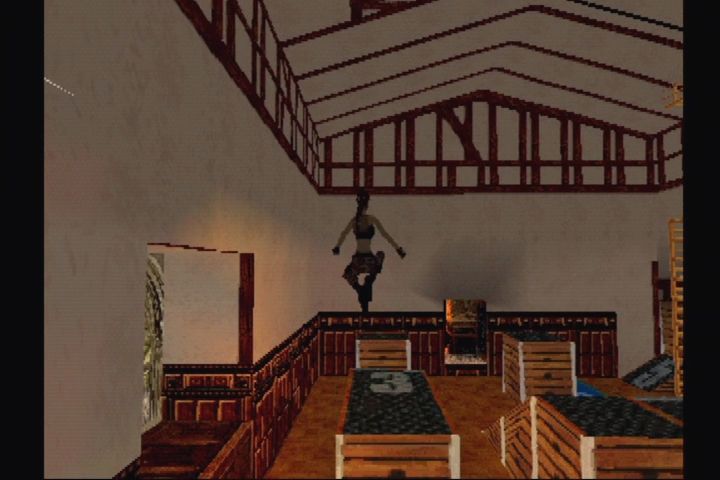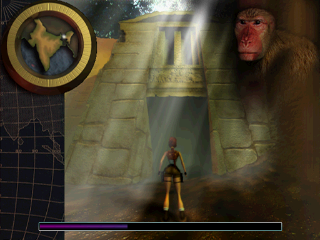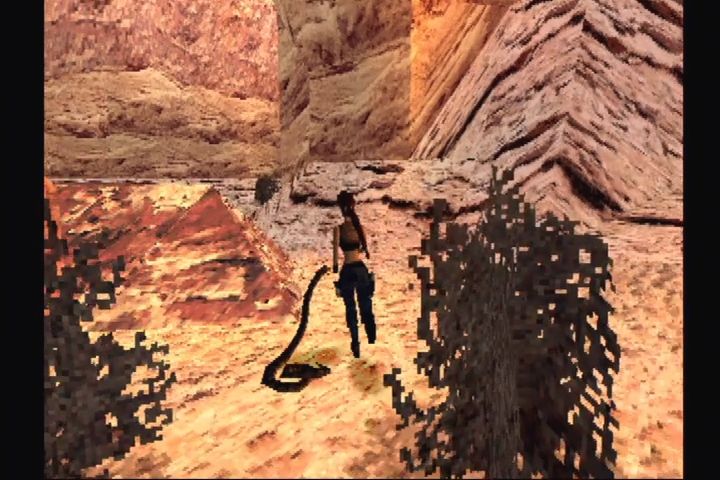Retro Replay Review
Gameplay
Tomb Raider III builds on the series’ signature blend of platforming, exploration, and puzzle-solving, delivering levels that feel both expansive and meticulously crafted. After an introductory trek through the Indian jungle, players gain the freedom to tackle the remaining three artifact expeditions in any order, creating a semi-nonlinear structure that enhances replay value. Each location presents unique environmental challenges, from suffocating quicksand pits to icy caverns where slippery surfaces and freezing water threaten Lara’s stamina.
(HEY YOU!! We hope you enjoy! We try not to run ads. So basically, this is a very expensive hobby running this site. Please consider joining us for updates, forums, and more. Network w/ us to make some cash or friends while retro gaming, and you can win some free retro games for posting. Okay, carry on 👍)
Lara’s move set remains impressively versatile. She can sprint, roll, and swim, but this installment introduces time-limited dives in frigid water and underwater predators such as piranhas, requiring careful air management and route planning. Quicksand sequences force players to balance movement speed with cautious navigation, while swinging on vines and bars is more fluid than ever, thanks to refined control responsiveness.
Combat encounters blend ranged firefights with moments of stealth. In addition to returning favorites like dual pistols and the harpoon gun, Lara wields the formidable Desert Eagle, MP5 sub-machine gun, and rocket launcher. Certain levels encourage a low-profile approach, rewarding players who sneak past foes instead of engaging in full-scale battles. Ammo is scarce, so resource management becomes critical to survive both enemy soldiers and environmental hazards.
Graphics
For its time, Tomb Raider III’s visuals represented a leap forward in polygonal character modeling and environmental detail. Lara moves with smoother animations, and enemies exhibit more realistic behaviors and varied attack patterns. Each region—be it the overgrown jungles of India or the sunken ruins of Polynesia—features distinctive color palettes and atmospheric lighting that immerse players in remote locales.
Textures may seem dated by modern standards, but the game’s pre-rendered backgrounds cleverly mask hardware limitations, creating convincing depth and scale. Water effects, particularly cold, murky pools teeming with hostile creatures, showcase early experiments in caustic lighting and reflective shaders. Quick transitions between open areas and narrow corridors maintain visual consistency while hiding draw-in pop and clipping.
Cutscenes are integrated seamlessly, using in-engine cameras to highlight dramatic reveals and artifact discoveries. Character portraits and on-screen text provide narrative context without jarring shifts in style. While performance on original hardware could fluctuate during complex set pieces, modern ports and emulation smooth out frame rates, allowing players to fully appreciate the graphic designs.
Story
In Tomb Raider III, Lara Croft’s quest begins in India, where she recovers the legendary Infada Stone from an ancient tribe. Her victory is short-lived as Dr. Willard, head of the enigmatic RX Tech, persuades Lara that this stone is one of four celestial artifacts fashioned from a prehistoric meteorite. Driven by both scientific curiosity and the thrill of discovery, Lara sets out to locate the remaining relics scattered across the globe.
The narrative unfolds through in-game cutscenes and scattered journals, weaving archaeology with mythology. Dr. Willard’s true motives remain ambiguous, casting a shadow of corporate greed over the mission. Each chapter’s atmosphere—from bustling London streets to frigid Antarctic bases—reinforces the stakes of Lara’s pursuit, while environmental storytelling hints at the tragic fate of ancient civilizations.
Although the plot occasionally leans on familiar adventure tropes, it succeeds in motivating diverse level designs and puzzle themes. Discovering the meteorite’s influence on prehistoric cultures adds an intriguing sci-fi twist. The story’s pacing keeps players engaged, balancing exposition with moments of high-octane action and reflective exploration.
Overall Experience
Tomb Raider III stands as a landmark title that refines the formula established by its predecessors. Its open-ended level progression invites multiple playthroughs, each revealing hidden shortcuts, secret caches of ammo, and bonus chambers overflowing with relics. The blend of platforming precision, challenging puzzles, and varied combat scenarios ensures that no two levels feel alike.
While modern audiences may notice the game’s dated control scheme and occasional camera quirks, these idiosyncrasies contribute to its nostalgic charm. Difficulty spikes can be punishing—unexpected falls or ambushes demand quick reflexes and careful save-point management. Fortunately, the PC and console versions allow on-demand saves, alleviating frustration during marathon sessions.
Ultimately, Tomb Raider III: Adventures of Lara Croft rewards players who appreciate classic 3D action-adventure design. Its robust level design, atmospheric locales, and charismatic heroine combine into an experience that has endured for decades. For gamers seeking a challenging expedition filled with secrets and thrills, Lara’s third outing remains a must-play journey.
 Retro Replay Retro Replay gaming reviews, news, emulation, geek stuff and more!
Retro Replay Retro Replay gaming reviews, news, emulation, geek stuff and more!









Reviews
There are no reviews yet.